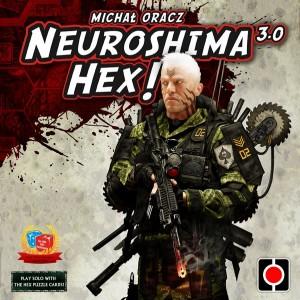 The inevitable has happened. Humans finally went to war against the machines and the world as we know it has been destroyed. While that may sound familiar, I’m not talking about the rise of Skynet and the T-1000s (at least not today). No, I’m talking about the world of Neuroshima, where the remains of humanity have taken shelter in the ruins of cities, organized into small communities, gangs, and armies. And what happens when resources are scare and opposing factions vie for control? You guessed it. War.
The inevitable has happened. Humans finally went to war against the machines and the world as we know it has been destroyed. While that may sound familiar, I’m not talking about the rise of Skynet and the T-1000s (at least not today). No, I’m talking about the world of Neuroshima, where the remains of humanity have taken shelter in the ruins of cities, organized into small communities, gangs, and armies. And what happens when resources are scare and opposing factions vie for control? You guessed it. War.
Today we are going to dive into Neuroshima Hex 3.0, published by Portal Games and designed by Michal Oracz. In this highly tactical board game, players take control of one of four unique factions trying to survive in this devastated world. Now in its 3rd Edition, Neuroshiuma Hex has garnered quite the following over the years. So let’s dive into this hex-based board game and see if it’s time for us to join their legions.
Neuroshima Hex is a tactical, tile-laying war game for 2-4 players that takes about 30-45 minutes to play. Neuroshima Hex plays best with 2-3 players.
Game Overview:
The goal of the game in Neuroshima Hex is to attack your opponent’s headquarters (HQ). Each HQ at 20 hit points and if your HQ is ever reduced to zero, you lose. During the game, players will be drawing tiles which are composed of units, modules, and action tokens. These are then placed onto the board in strategic positions. Once a battle is started, units attack in an initiative order, damaging other tiles on the board and possibly an HQ.
Strong tactical decisions are a must if you hope to win at Neuroshima Hex. The game ends in one of two ways. If your HQ is destroyed, you lose. The game also ends when a player has played their last tile. After one final battle, the player who’s HQ has the most life left, is the winner.
Game Components:
While Neuroshima Hex doesn’t come with a huge pile of components, the things that are included are really well produced. The game board is comprised of a series of hexagons, well-illustrated to really fit the theme. As a big fan of post-apocalyptic fiction, I really enjoyed the theme in Neuroshima Hex and like the artwork used in the game. .
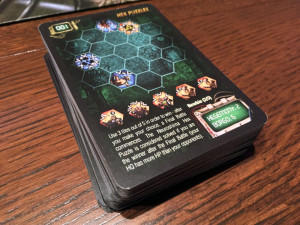
This 3rd edition of Neuroshima Hex comes with 4 unique armies:
The Outpost – The last bastion of humanity, their units are known for being very mobile.
The Moloch – The hordes of machines, their units are known for their strong ranged combat and toughness.
The Borgo – An army of genetically engineered mutants – They are known for their high initiative levels and strong melee fighters.
The Hegemony – A Land ruled by gangs waging constant war for domination – They are known for being a very flexible and adaptable army.
Each of these armies comes with their own set of tiles, all illustrated with some of Neuroshima Hex’s fantastic post-apocalyptic artwork. Each army is comprised of a number of units (fighters), modules (they improve attached fighters), and actions tokens (one time use items). Each army also has a great “cheat sheet” that explains every tile in detail and also provides some interesting back story.
In addition to the armies, Neuroshima Hex also comes with a deck of cards for a solo game, called Hex Puzzles. I felt like these were a great addition. They have pre-set game states where players have to figure out how to win in one turn. They remind me of the Magic: The Gathering puzzles that appear in the iOS app. I love things like this.
How to Play:
While the rule book clocks in at about 24 pages, only about 8 of those pages are actual game rules. What that means is that Neuroshima Hex is a really easy game to pick up.
To start, each player choose an army and places their HQ on the board. Starting with the first player, players will alternate taking turns in the following manner:
On your turn you draw up to 3 tiles from your face down tile pool and place them face up in front of you. Then you must then discard of the tiles. With the remaining two tiles, you have three options: Place them on the board, discard them, or keep them for a later turn. Once that is done, the next player takes their turn.
As mentioned earlier, there are three types of tiles in the game:
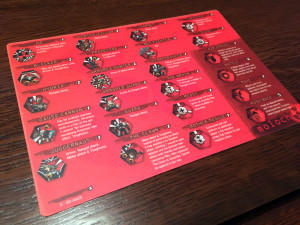
Unit tiles: These represent your soldiers. Most unit tiles have triangles on one or more of their sides. These triangles indicate which sides the unit can attack from (and if the attack is ranged or melee). Some also have special abilities, denoted by icons on the tiles (and further explained on a player’s cheat sheet)
Modules: These affect any units they are connected to. They do things like adding attack power, preventing damage, and increasing the unit’s initiative.
Instant Action Tiles: These are one time use tiles that aren’t placed on the board. They let you do things like move previously placed units, launch bombs, or start battles early.
Speaking of battles, a battle begins immediately once every hex on the board is filled (or when someone plays a battle tile). To battle, each troop gets to attack in descending initiative order. So starting with the units with the highest initiative, you check their triangles and attack any units they would hit. All units with the same initiative attack simultaneously. However, if you can destroy a unit with a lower initiative, it won’t get to attack in this battle. Most battles end with initiative zero, where player’s HQs attack (they each have a melee attack on all sides).
Any damage to an HQ is tracked on a separate, dial counter. Rounds continue with placement and battles until either one HQ is destroyed (that player loses) or a player has played their last tile. In which case, the other player gets one last turn and a final battle occurs. The player who’s HQ has the most life left is the winner.
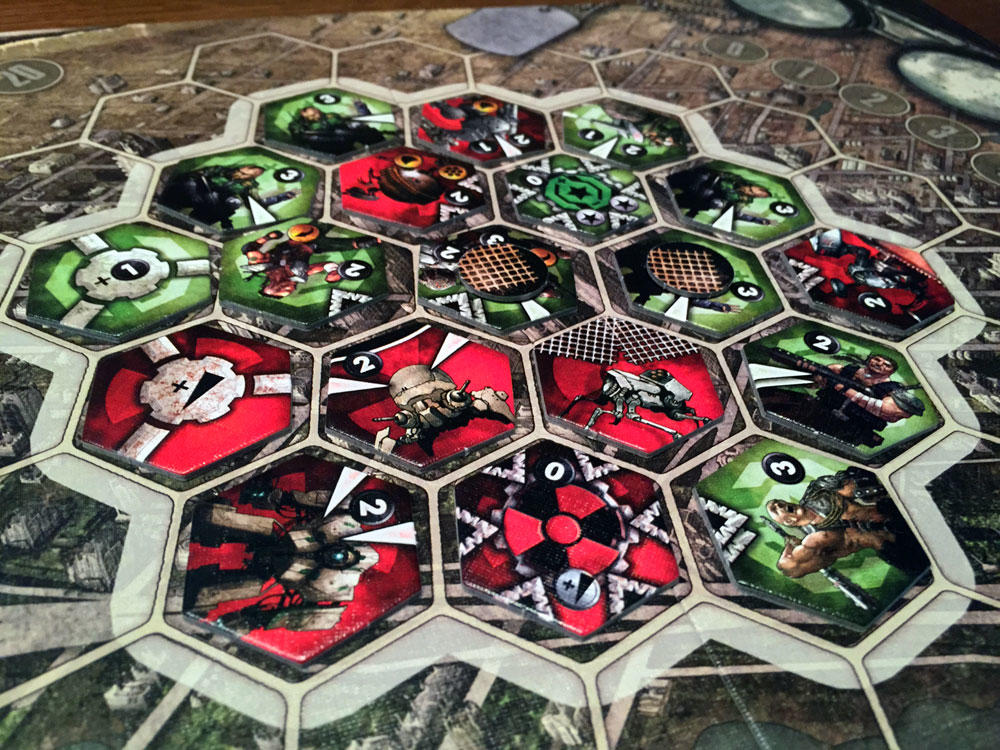
Game Experience:
Neuroshima Hex was first published in 2006 and I now find myself wondering…what the heck is wrong with me for waiting so long to play this game! I’ll admit it; I saw the game a while back and I didn’t really get the appeal of the hex based game. Maybe that goes back to my days of RPGs and old war games where now, anything with a hex, just feels a bit dated. It’s irrational I know, but it’s hard to shake that feeling.
Today, I know that I’m a giant dummy for passing up on this title some many times. Neuroshima Hex is awesome. I love it. It’s a highly tactical game with some fantastic balance. Every turn you will be assessing the game state and must work with your limited tiles to try and swing the balance of the game back in your favor. It requires planning, hard decisions, and some careful strategy. There are no dice in the battles, so you can really plan out your attacks and defenses. The only randomness in the game comes from the tile draws (more on that later).
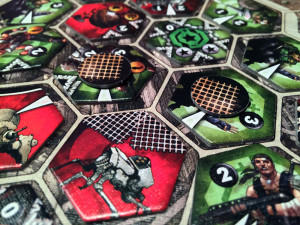
One of the best things about Neuroshima Hex is the 4 different armies that come with the base game (there have since been a few expansions released). As noted above in the game components, the factions all have their own strengths and weaknesses and really do feel unique in their own right. But the best part of these 4 armies is that they truly do feel balanced. Just as I find myself thinking one faction is clearly dominant over the rest, I get spanked in a game to remind me of how wrong I am. Let’s give kudos to designer Michal Oracz on some great work here.
If I had one complaint about Neuroshima Hex (and to be honest, I really only do have 1) is that the random draw of the tiles can sometimes cause frustrations in the game. I have played games where I don’t even draw a unit tile until round 5. This can be maddening, especially when your opponents has drawn a powerful unit and are pounding on your HQ. The game does have a “mulligan rule” where if you draw only instant tiles, you can discard them and redraw. But it can be painful to discard your one “bomb” tile so early in the game.
I haven’t decided how much that luck of the draw is a hindrance to the game. Whether you are drawing units early or late, chances are you will get them all eventually. I’ve found most of our games end when someone runs out of tiles vs an HQ being destroyed. This makes me think that not getting units out early isn’t really that big of a deal.
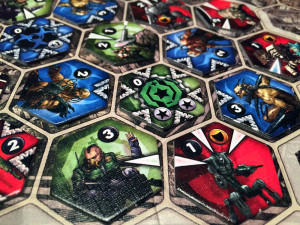
After reading through the rule book (which is laid out pretty well), I was really interested in the 3-player optional deathmatch rule. For the most part, I hate playing these types of games with more than two players. Games like Magic: The Gathering or Ashes: Rise of the Phoenixborn are great games when you play with only two. However, once you get into 3 and 4 players, the balance quickly falls apart. The games usually devolve into “play cautiously, until someone takes some damage, then let’s all gang up on that player and eliminate them”. It’s a sounds strategy, but not fun at all for the player taking the beating.
So I was prepared to bash Neuroshima Hex for falling into that same trap. However, the 3 player alternate deathmatch rule was actually pretty ingenious. Everyone’s HQ starts at zero, instead of twenty. You get a point anytime you damage anyone’s HQ. The game ends when someone plays their last tile, as usual. This eliminates the need to gang up on any one player (unless you just don’t like them). I loved this game mode and it really made a 3-4 player game of Neuroshima Hex both viable and fun (although with 4 players the game can get a tad chaotic).
Finally, I want to talk about battles. At first, I was worried that it would be really fiddly and cumbersome trying to track initiative and battle results. You have to figure out who each unit damages and when. But to be honest, it was nowhere near as bad as I thought it’d be. This is especially true after you get a few games under your belt. You scan the board, seen when units activate, and apply the damage. It’s actually surprisingly intuitive. And since all players have vested interest in making sure combat is resolved correctly, someone will usually be quick to point out anything done in error.
Final Thoughts:
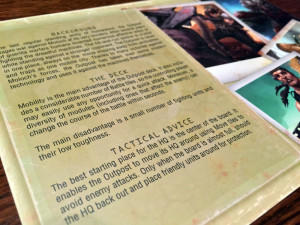
Neuroshima Hex is a game that’s been out for almost a decade that I’m not kicking myself for not getting earlier. It’s fun, tactical, unique, and easy to learn. Much like chess, it’s absolutely one of those games that’s easy to learn yet difficult to master.
My one major problem with Neuroshima Hex is that I don’t have a dedicated opponent to play with. I seriously want to buy every single expansion for this game and try them all out. I don’t usually gravitate towards abstract games, but for some reason this one just sucked me in and wouldn’t let go. I now get why Neuroshima Hex has been reprinted again and again over the past decade.
But if you are looking for a great game that’s both unique, well produced, and contains a ton of replay value, than look no further than Neuroshima Hex. While the abstract nature of the game or the randomness of the draw may turn some players off, the rock solid mechanics and engaging game play more than make up for that. Neuroshima Hex has become a game that I’ll always be trying to get to the gaming table.
If you’d like to get a copy of Neuroshima Hex 3.0, you can pick it up for about $40
Final Score: 5 Stars – A unique abstract war game that has completely sucked me in with it’s fun game play. Welcome to my new addiction.
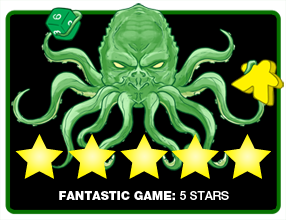 Hits:
Hits:
• Solid and unique game mechanics
• Easy to learn, difficult to master
• 4 factions that all feel different when you play them
• Brilliant solution for 3-4 player games.
Misses:
• Randomness of the tile draw can sometimes cause frustrations







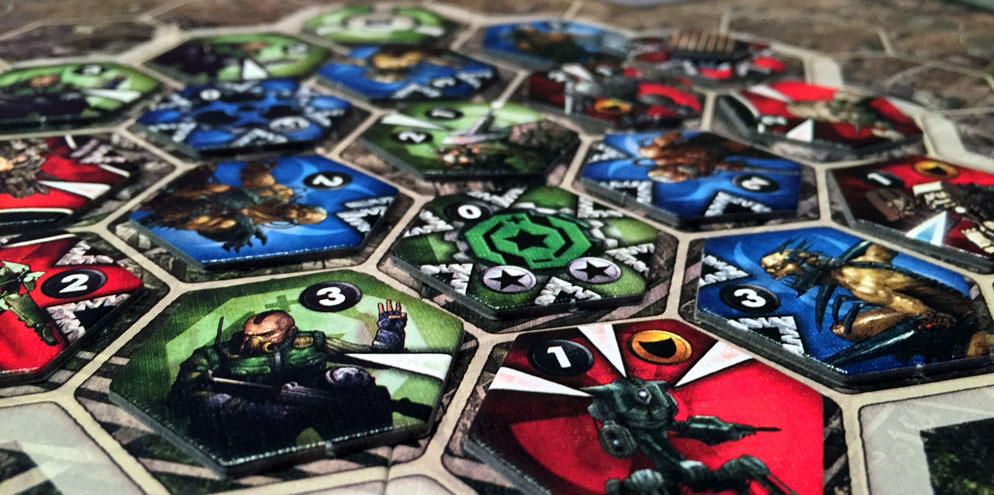















play it on ipad or iphone – you can play online too.
Oh I do. I’ve probably played over 150+ games on my ipad lately. 🙂